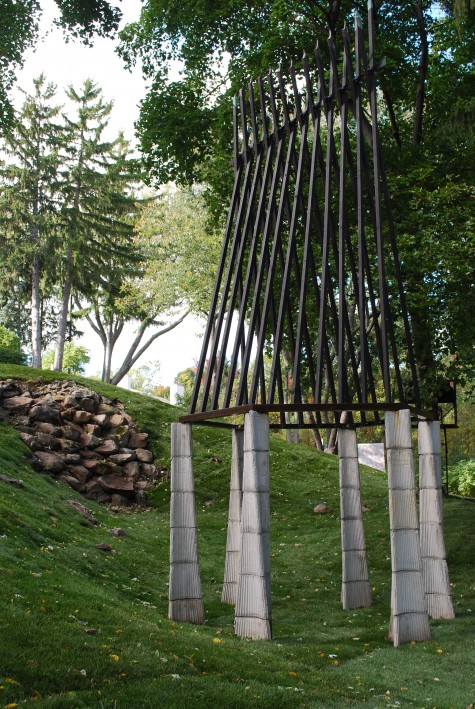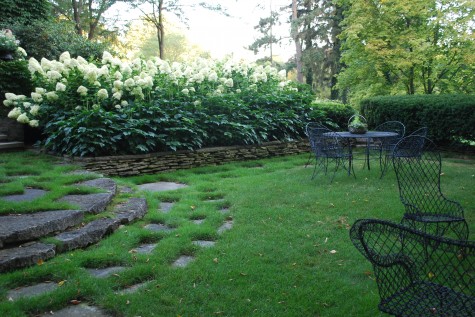 A place to be, a beautifully organized and finished space, a landscape composition-beautiful views go by many names. I love plants as much as the next gardener, but I have a bigger interest in the plants being integrated into a whole that makes a strong statement and engages the eye. Gardens are perpetually unfinished, but a good thought moving towards completion delights me the most. Of course I think that-I am serious about designing landscapes. This landscape-I have worked here 25 years. 25 years means time to evolve, time to attend to the little details, time to be surprised by what unexpectedly happens, time to take an idea, and grow up with it.
A place to be, a beautifully organized and finished space, a landscape composition-beautiful views go by many names. I love plants as much as the next gardener, but I have a bigger interest in the plants being integrated into a whole that makes a strong statement and engages the eye. Gardens are perpetually unfinished, but a good thought moving towards completion delights me the most. Of course I think that-I am serious about designing landscapes. This landscape-I have worked here 25 years. 25 years means time to evolve, time to attend to the little details, time to be surprised by what unexpectedly happens, time to take an idea, and grow up with it.
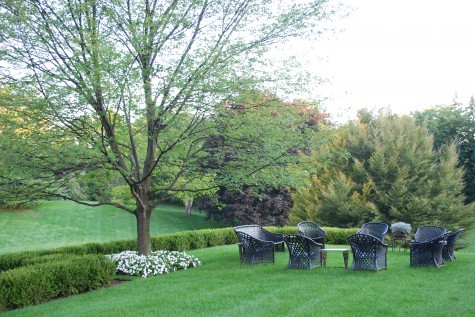 My client is an afficianado of the classic English landscape park. She admires the work of Capability Brown, an 18th century English landscape architect who designed upwards of 170 park landscapes. His landscapes were simple, and natural-as opposed to formal and structured. But as much as he sought to simply represent nature, there is much evidence of his hand. My client likes putting a subtle and natural hand to her landscape. Most strikingly, the old trees grow out of the lawn-sans barked circles around their trunks. Mulching trees with bark conserve moisture, and are something of a defense against damage from a string trimmer-but they are anything but natural looking. There is no bark anywhere on this property. Many years ago we regraded the entire back yard, with the idea in mind of creating interest at the ground plane. The ground rolls, dips and goes flat-most of this sculpture is covered with grass. Her early 20th century tudor home, built on a substantial piece of property, makes that thought to establish a park entirely believable.
My client is an afficianado of the classic English landscape park. She admires the work of Capability Brown, an 18th century English landscape architect who designed upwards of 170 park landscapes. His landscapes were simple, and natural-as opposed to formal and structured. But as much as he sought to simply represent nature, there is much evidence of his hand. My client likes putting a subtle and natural hand to her landscape. Most strikingly, the old trees grow out of the lawn-sans barked circles around their trunks. Mulching trees with bark conserve moisture, and are something of a defense against damage from a string trimmer-but they are anything but natural looking. There is no bark anywhere on this property. Many years ago we regraded the entire back yard, with the idea in mind of creating interest at the ground plane. The ground rolls, dips and goes flat-most of this sculpture is covered with grass. Her early 20th century tudor home, built on a substantial piece of property, makes that thought to establish a park entirely believable.
Old stone walls, old trees, and but a few flowers-usually white- make for beautiful, and entirely serene views. I like landscapes that suggest reverie. I am not so much a fan of landscapes that are noisy or demanding. I see some landscapes I would describe as overwrought. The red leaved maples planted next to the chartreuse foliaged thuja-very lively. I like to visit landscapes with great visual excitement, but at home, I want sanctuary. It is very important to think about what you want and need from a garden before you plant.
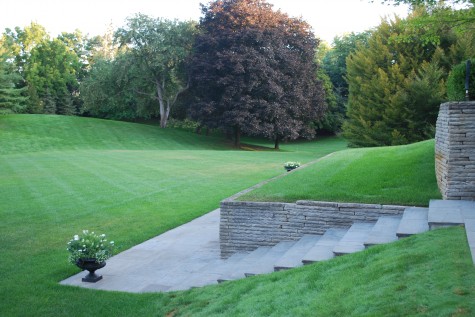
A property of this size is unusual in an urban community. The public parks that exist in my community tend to be outfitted with benches, playgrounds, softball fields and the like. A landscape park can make much about what is not there. This landscape is quietly contemplative in feeling. The presence of the client is felt only in how beautifully she maintains her property.
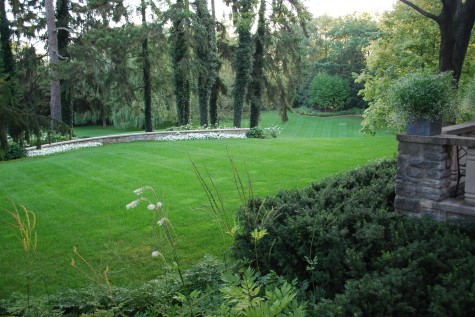
There have been plenty of changes over the past 25 years, but they are hard to spot. This lawn area was once home to a swimming pool of natural and irregular shape. On occasion she will entertain outdoors; the light in early evening is beautiful in this spot.
The pool had become a considerable burden to maintain, as it was very old and always in need of some kind of repair. The lawn area into which it was set was lumpy and difficult to navigate. When the pool was removed, the lawn was regraded level enough to make entertaining comfortable.
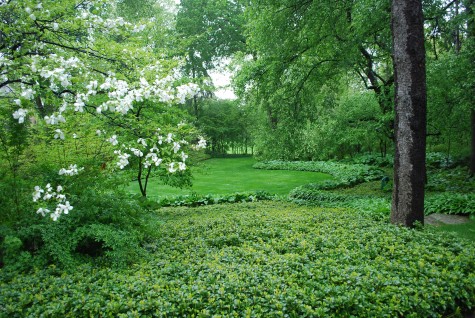 It takes many years to cover large spaces such as this one with plants. There are thriving colonies of plants here-not 3 of this or five of that. Save the mature trees, no one plant stands out and demands recognition.
It takes many years to cover large spaces such as this one with plants. There are thriving colonies of plants here-not 3 of this or five of that. Save the mature trees, no one plant stands out and demands recognition.
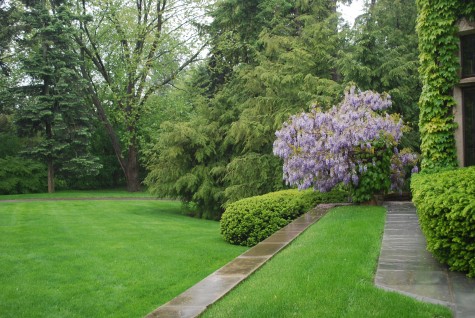 There are those unexpected moments. This wisteria has been in this spot as long as I have worked here. This spring’s show was particularly showy. The landscape near the house, glimpses of which can be seen in this photograph, are very formal and simple. They contrast with the flowing lines of the greater landscape-but in a quiet way.
There are those unexpected moments. This wisteria has been in this spot as long as I have worked here. This spring’s show was particularly showy. The landscape near the house, glimpses of which can be seen in this photograph, are very formal and simple. They contrast with the flowing lines of the greater landscape-but in a quiet way.
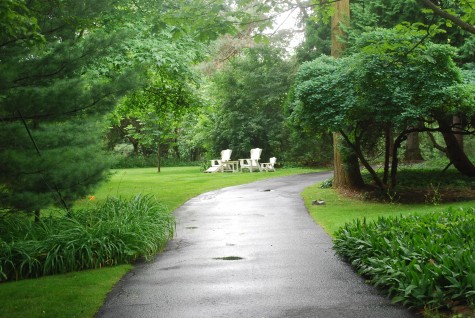
Another client with whom I am working now is studying this view of her vintage Adirondacks furniture. Should the old honeysuckle thicket behind be removed, in order to open a view to the bigger landscape beyond? Do the chairs need the company, or would they be more beautiful set against the big expanse of lawn behind them? We are thinking about it.


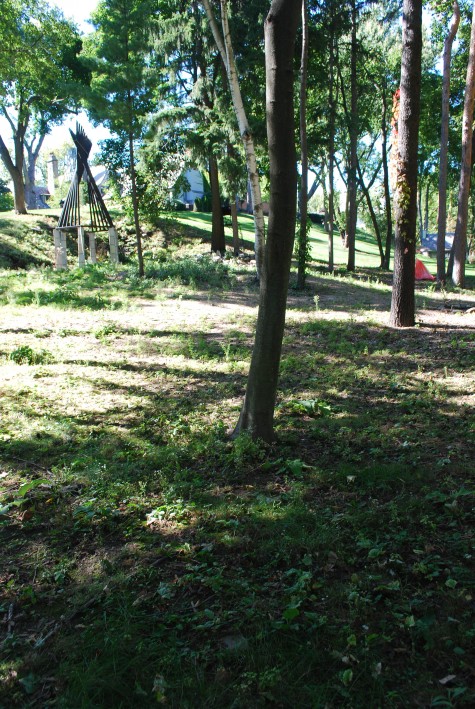 For years my client and I had been looking at a certain giant blob of a thicket on her property. Lanky buckthorn, lilac and other unkempt and untended shrubs had made the space impenetrable. The fact that the area was on a steep slope made investigating what was there all the more difficult.Not knowing what was in there made it easy to just mow around it, and act like it was part of a landscape. Every so often she would talk about what might be in there; this went on for some years.
For years my client and I had been looking at a certain giant blob of a thicket on her property. Lanky buckthorn, lilac and other unkempt and untended shrubs had made the space impenetrable. The fact that the area was on a steep slope made investigating what was there all the more difficult.Not knowing what was in there made it easy to just mow around it, and act like it was part of a landscape. Every so often she would talk about what might be in there; this went on for some years. 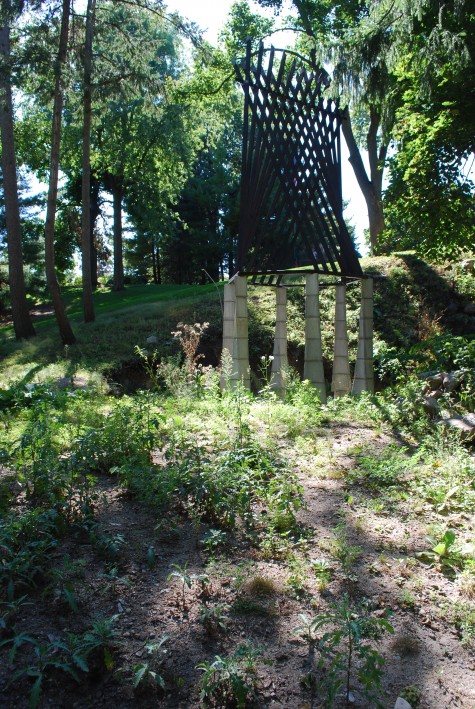 One day she called to say she had clear cut the entire spot, and discovered an old rock waterfall and pool. No doubt it dated back to the 1920’s. The precipitous drop, lined with giant rocks, was entirely stable. There was a lot of discussion about restoring the watefall and pool, which led to some discussion of a new fountain; more years went by. One day she called to say she wanted me to look at the space again-I thought as the thicket was threatening to grow back-we were being chased for a plan. How like her to install an enormous concrete and wood sculpture in the center of the old pool. This is so distinctively her way of working things out. Making a move like that was forcing everyone’s hand. I told her I thought a sculpture of this size and proportion needed its own park.
One day she called to say she had clear cut the entire spot, and discovered an old rock waterfall and pool. No doubt it dated back to the 1920’s. The precipitous drop, lined with giant rocks, was entirely stable. There was a lot of discussion about restoring the watefall and pool, which led to some discussion of a new fountain; more years went by. One day she called to say she wanted me to look at the space again-I thought as the thicket was threatening to grow back-we were being chased for a plan. How like her to install an enormous concrete and wood sculpture in the center of the old pool. This is so distinctively her way of working things out. Making a move like that was forcing everyone’s hand. I told her I thought a sculpture of this size and proportion needed its own park.  The sculptor had sunk concrete pilings in giant sonatubes. Still visible in the above picture, it was apparent no small amount of grading was needed. My client was concerned that the pool would hold water. The rim of outside soil needed to be taken down. A giant pile of rocks collected from the first clear cutting went into the hole first. Trapping water near the sculpture would not be a good idea.
The sculptor had sunk concrete pilings in giant sonatubes. Still visible in the above picture, it was apparent no small amount of grading was needed. My client was concerned that the pool would hold water. The rim of outside soil needed to be taken down. A giant pile of rocks collected from the first clear cutting went into the hole first. Trapping water near the sculpture would not be a good idea.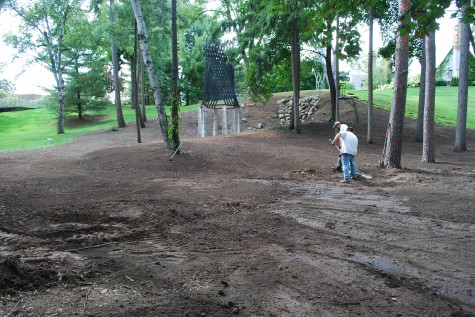 A skid steer made quick work of removing the weedy growth that had begun to take hold. I have watched the history channel television series called “Life After People” with great interest. It is astonishing how little time it takes for untended ground to go to rack and ruin. Nature abhors a vacuum; any bare dirt will have something going on in short order. Ignore a space, and nature will take over in your absence.
A skid steer made quick work of removing the weedy growth that had begun to take hold. I have watched the history channel television series called “Life After People” with great interest. It is astonishing how little time it takes for untended ground to go to rack and ruin. Nature abhors a vacuum; any bare dirt will have something going on in short order. Ignore a space, and nature will take over in your absence. 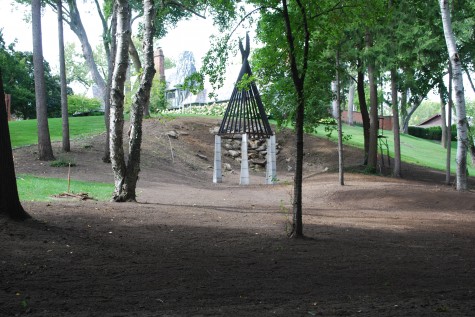 The front edge of the old pool was lowered to permit water to escape. I so love this point in a landscape project; bare sculpted dirt is incredibly beautiful. A landscape of evergreens planted in sculpted, cultivated soil-a landscape of my dreams. Barked areas in a garden leave me cold-I like to cover the ground with plants, or see dirt. I mulch strictly to conserve moisture in the soil. The pattern of light and dark on the ground here is telling. The old waterfall and pool were situated in a patch of sun. The sculpture benefits from this.
The front edge of the old pool was lowered to permit water to escape. I so love this point in a landscape project; bare sculpted dirt is incredibly beautiful. A landscape of evergreens planted in sculpted, cultivated soil-a landscape of my dreams. Barked areas in a garden leave me cold-I like to cover the ground with plants, or see dirt. I mulch strictly to conserve moisture in the soil. The pattern of light and dark on the ground here is telling. The old waterfall and pool were situated in a patch of sun. The sculpture benefits from this. 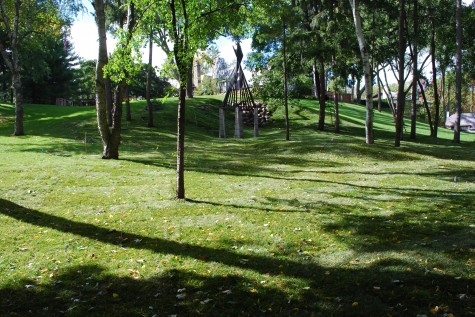 New lawn softens all the hard edges. The rolling, swelling and dipping of the ground makes for a big fluid situation for the starkly vertical sculpture on its big legs. They look good together.
New lawn softens all the hard edges. The rolling, swelling and dipping of the ground makes for a big fluid situation for the starkly vertical sculpture on its big legs. They look good together.  The fountain rockwork we left exposed. It is a part of the history of the property. Practically speaking, I would never have removed those giant stones; they have stabilized soil existing at a very steep angle. In the spring, my client will be able to pick and choose what she mows, and what she chooses to let be. There is a sculptural element yet to come-the decision about how and where to cut the lawn.
The fountain rockwork we left exposed. It is a part of the history of the property. Practically speaking, I would never have removed those giant stones; they have stabilized soil existing at a very steep angle. In the spring, my client will be able to pick and choose what she mows, and what she chooses to let be. There is a sculptural element yet to come-the decision about how and where to cut the lawn.